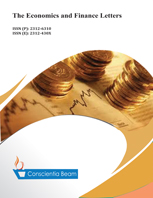Impact of Asymmetric Government Spending on Real Balances Demand
DOI:
https://doi.org/10.18488/journal.29.2019.61.57.66Abstract
This paper uses time series technique on Nigeria’s data spanning over 20 years, 1995Q1 to 2018Q1 in order to examine the impact of asymmetric government spending on money demand. Taking into account the recent empirics and methodological approach in money demand function such as income decomposition in public and private sectors, an augmented empirical model of real balances demand was applied which underscores the positive and negative changes in government. The empirical results show a positive value of real government spending accounting for 30 per cent changes in long-term demand for real balances. However, the negative value of real government spending influence accounts for 20 per cent real balances demand in the long-term. This inquiry, thus contributes to the literature on the demand for real balances by focusing on the cyclical behavior of fiscal policy in Nigeria that has not so far been systematically tested. The findings on real government spending effect also suggest that bureau de change exchange rate and financial innovation have a negative and significant impact on money demand, which is consistent with findings of existing literature. The degree and direction of asymmetry provide a novel dimension to fiscal policy shock toward improving the outcome of stabilization policies.

